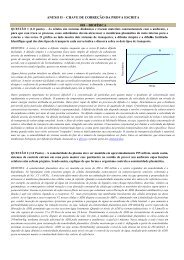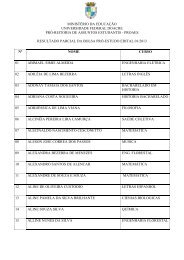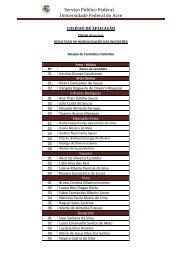Revista Brasileira de Ornitologia - Universidade Federal do Acre
Revista Brasileira de Ornitologia - Universidade Federal do Acre
Revista Brasileira de Ornitologia - Universidade Federal do Acre
Create successful ePaper yourself
Turn your PDF publications into a flip-book with our unique Google optimized e-Paper software.
Birds of the Brazilian state of <strong>Acre</strong>: diversity, zoogeography, and conservationEdson Guilherme407of local species is best un<strong>de</strong>rstood in an east-west, ratherthan a north-south dimension, with the Purus Riverforming the principal division within the state. The Purusdivi<strong>de</strong>s <strong>Acre</strong> into two main portions, an eastern portionon its right margin, and western portion to its left margin(Figure 2).Of the resi<strong>de</strong>nt forest taxa in <strong>Acre</strong>, almost 80% arewi<strong>de</strong>ly distributed within the state, being found in bothits eastern and western portions. Among other things, thisreflects the mostly low-lying terrain (except in the westernextreme) and relatively homogeneous habitats foundthroughout most of the state. This low species turnoverwould be expected in the absence of major physicalbarriers, such as rivers or mountains, capable of limitingthe dispersal of most taxa. However, some taxa onlyoccur in one of the state’s two sub-regions, although thisdistribution pattern appears not related to the presenceof the two main rivers that cross the state, the Purus andthe Juruá. This may be primarily due to the fact that thesehighly mean<strong>de</strong>ring rivers arise in lowland Amazonia, andso, taxa can cross them often more easily than they wouldrivers whose headwaters are in unsuitable habitat (such asdry country or mountains). Genetic studies of primates(Peres et al. 1996), ro<strong>de</strong>nts (Patton et al. 1994; Patton andSilva 1998), birds (Aleixo 2004, Fernan<strong>de</strong>s et al. 2012),and amphibians (Gascon et al. 1998) have all confirmedthat the Juruá is an ineffective zoogeographic barrier forthese groups.Other factors may nevertheless influence thedistribution of different taxa in southwestern Amazonia,including interspecific competition, edaphic conditionsand habitat characteristics (Tuomisto et al. 1995, 2003;Daly & Silveira, 2002; Roig & Martini, 2002; Silveiraet al. 2002). A closer examination of the geographicdistribution of birds within one of the sub-regions(Appendix 1) reveals that the pattern observed in <strong>Acre</strong> isrepeated on the Peruvian si<strong>de</strong> of the bor<strong>de</strong>r. Species suchas Phlegopsis erythroptera, Thamnomanes saturninus, Attilacitriniventris, Pipra filicauda, and Dixiphia pipra havealso been recor<strong>de</strong>d only in northeast Peru (Schulenberget al. 2007). Similarly, Poecilotriccus albifacies, Cnipo<strong>de</strong>ctessuperrufus, and Micrococcyx cinereus, which were onlyfound in eastern <strong>Acre</strong> (Appendix 1), were also found onlyin adjacent southeastern Peru (Schulenberg et al. 2007).A similar pattern has also been recor<strong>de</strong>d for palms(Arecaceae) in <strong>Acre</strong>. Some species, such as Wettiniaaugusta, Syagrus smithii, Socratea salazarii, Iriartellastenocarpa, Hyospathe elegans, Dyctyocaryum ptarianum,Bactris riparia, and Astrocaryum faranae, are foun<strong>do</strong>nly in the western sub-region of <strong>Acre</strong> (Lorenzi et al.2004). Other species, such as Astrocaryum aculeatum,Astrocaryum murumuru, and Bactris elegans are restrictedto the eastern part of the state (Lorenzi et al. 2004). Eventhough practically all these species of palm also occurin areas adjacent to <strong>Acre</strong>, their east-west distributionwithin the state is similar to that observed in some birdspecies (Appendix 1). Some of these palm species arealso restricted to specific environments, such as plateaus,swamps, campinas, and campinaranas. This distributionpattern in <strong>Acre</strong> may be a reflection of the sedimentaryhistory of the Marañon–Ucayali–<strong>Acre</strong> basin, to the west,and the Madre <strong>de</strong> Dios basin, to the east. In the westernpart of the state, relatively ancient formations (e.g.,Fm Moa, Rio Azul, Divisor and Cruzeiro <strong>do</strong> Sul) wereexposed by the uplift of the An<strong>de</strong>s, and contrast withthe more recent Cenozoic formations in the east partsof the state, e.g., Fm Solimões and Fm Madre <strong>de</strong> Dios(Milani & Thomaz Filho, 2000, Campbell et al., 2006).In western <strong>Acre</strong>, the topography and variations in thecomposition of the soil have played an important role inthe formation of distinct ecosystems, which may certainlyhelp to explain the higher number of species of palms andbirds (and probably others groups of organisms) restrictedto western <strong>Acre</strong> (Lorenzi et al. 2004, Guilherme, 2009).For most of the species restricted to one of the subregions,<strong>Acre</strong> and the adjacent lowlands of Peru representthe southwestern extreme of their distribution in theAmazon basin. Species such as Thamnomanes saturninus,Pipra filicauda (Figure 6), and Dixiphia pipra are wi<strong>de</strong>lydistributed in northern Amazonia, ranging south as faras the southwestern extreme of the Amazon lowlands(Ridgely & Tu<strong>do</strong>r, 2009). There are exceptions, however,such as Thamnophilus divisorius, which is en<strong>de</strong>mic towestern <strong>Acre</strong> and northeastern Peru. The distribution ofthis species is associated with an area of mo<strong>de</strong>rate altitu<strong>de</strong>,the submontane forests of the Serra <strong>do</strong> Divisor range.Many of the taxa restricted to the eastern sub-region of<strong>Acre</strong> are associated with bamboo forests (e.g., Picumnussubtilis, Cnipo<strong>de</strong>ctes superrufus, and Poecilotriccus albifacies)or <strong>de</strong>nse rainforest (e.g., Lepi<strong>do</strong>thrix coronata exquisita).Eastern <strong>Acre</strong> encompasses the greatest concentration ofthese habitats than the western portion of the state. Thissuggests that habitat-related environmental gradientsmay play a more important role in the distribution ofthe species in eastern <strong>Acre</strong> than the mere presence of aphysical barrier such as the Purus River. Other taxarestricted to eastern <strong>Acre</strong>, such as Crypturellus undulatusundulatus, Antrostomus sericocaudatus, and Herpsilochmusrufimaginatus, are more wi<strong>de</strong>ly distributed in the Amazonbasin, although this may represent the southwesternextreme of their distribution.Allopatric/parapatric rangesWhereas five pairs of purported sister taxa appear tohave an allopatric distribution in <strong>Acre</strong> (Table 1), it seemslikely that further ornithological surveys may confirmthat these taxa are actually parapatric in the state, and thattheir apparent allopatric distribution is merely a samplingartifact. A common feature of the taxa consi<strong>de</strong>red to be<strong>Revista</strong> <strong>Brasileira</strong> <strong>de</strong> <strong>Ornitologia</strong>, 20(4), 2012










